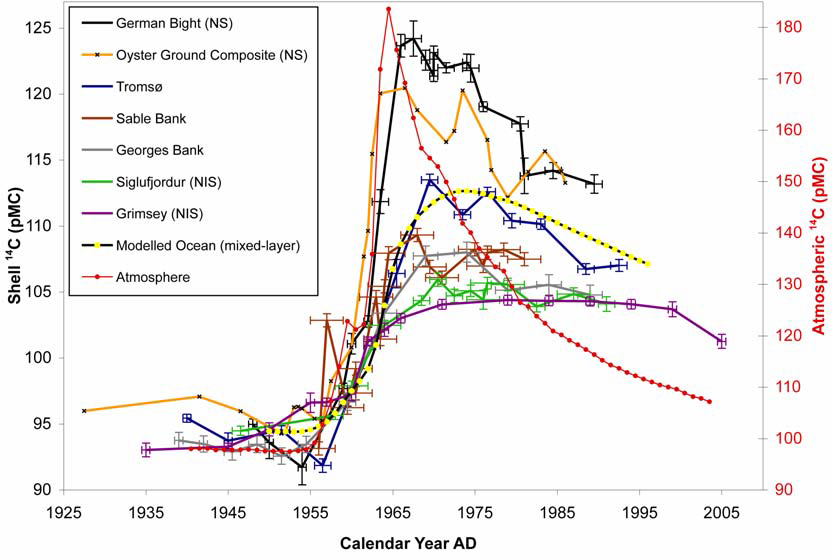The Marine Radiocarbon Bomb Pulse Across the Temperare North Atlantic: a Compilation of Δ14C Time Histories from Arctica Islandica Growth Increments
James D. Scourse1,2, Alan D. Wanamaker Jr3, Chris Weidman4, Jan Heinemeier5, Paula J. Reimer6, Paul G. Butler1, Rob Witbaard7 and Christopher A. Richardson1
1School of Ocean Sciences, College of Natural Sciences, Bangor University, Bangor LL59 5AB, United Kingdom
2Corresponding author. Email: j.scourse@bangor.ac.uk
3Department of Geological and Atmospheric Sciences, 253 Science I, Iowa State University, Ames, Iowa 50011-3212, USA
4Waquoit Bay National Estuarine Research Reserve, PO Box 3092, 149 Waquoit Highway, Waquoit, Massachusetts 02536, USA
5AMS 14C Dating Centre, Department of Physics and Astronomy, Aarhus University, DK-8000 Aarhus C, Denmark
6 14CHRONO Centre, Queen’s University Belfast, Belfast BT7 1NN, Northern Ireland, United Kingdom
7Department of Marine Ecology, Royal Netherlands Institute for Sea Research (NIOZ), PO Box 59, 1790 AB Den Burg, Texel, the Netherlands
![]() Data Files
Data Files ![]() Documentation (PDF file)
Documentation (PDF file)
Introduction
Marine radiocarbon bomb-pulse time histories of annually resolved archives from temperate regions have been underexploited. We present here series of Δ14C excess from known-age annual increments of the long-lived bivalve mollusk Arctica islandica from 4 sites across the coastal North Atlantic (German Bight, North Sea; Tromsø, north Norway; Siglufjordur, north Icelandic shelf; Grimsey, north Icelandic shelf) combined with published series from Georges Bank and Sable Bank (NW Atlantic) and the Oyster Ground (North Sea). The atmospheric bomb pulse is shown to be a step-function whose response in the marine environment is immediate but of smaller amplitude and which has a longer decay time as a result of the much larger marine carbon reservoir. Attenuation is determined by the regional hydrographic setting of the sites, vertical mixing, processes controlling the isotopic exchange of 14C at the air-sea boundary, 14C content of the freshwater flux, primary productivity, and the residence time of organic matter in the sediment mixed layer. The inventories form a sequence from high magnitude-early peak (German Bight) to low magnitude-late peak (Grimsey). All series show a rapid response to the increase in atmospheric Δ14C excess but a slow response to the subsequent decline resulting from the succession of rapid isotopic airsea exchange followed by the more gradual isotopic equilibration in the mixed layer due to the variable marine carbon reservoir and incorporation of organic carbon from the sediment mixed layer. The data constitute calibration series for the use of the bomb pulse as a high-resolution dating tool in the marine environment and as a tracer of coastal ocean water masses.
Details of Arctica islandica sample collection sites
| Site | Location | Water depth (m) | Year of collection | Number of specimens | Measurements per specimen |
| North Norway, Tromsø | 70°N, 19°E | 3 | 1993 | 1 | 14 |
| German Bight, southern North Sea | 54°N, 7°E | 37 | 1990 | 2 | 7–13 |
| Oyster Ground, southern North Sea (Witbaard et al. 1994) | 54°N, 4°E | 30–50 | 1988 | 2 | 5–13 |
| North Icelandic shelf, Siglufjordur | 66°N, 19°W | 22 | 1991 | 3 | 4–7 |
| North Icelandic shelf, Grimsey | 66°N, 18°W | 80 | 2006 | 6 | 1–6 |
| Georges Bank, NW Atlantic (Weidman and Jones 1993) | 41°N, 67°W | 76 | 1990 | 1 | 13 |
| Sable Bank (Kilada et al. 2007) | 44°N, 61°W | 33–70 | 2003 | 6 | 2–3 |

